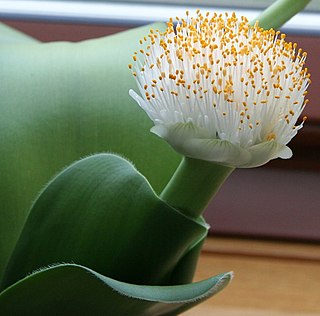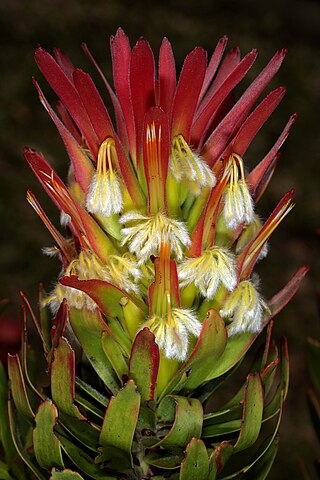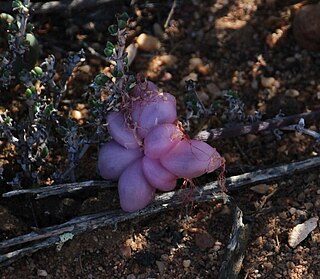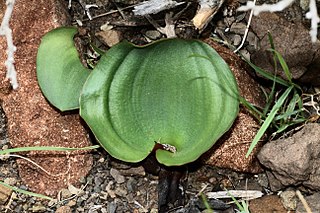
Haworthia is a large genus of small succulent plants endemic to Southern Africa (Mozambique, Namibia, Lesotho, Eswatini and South Africa).

Otholobium is a genus of flowering plants in the pea family with over 50 named species, but several also remain undescribed so far. Species may be herbaceous perennials, subshrubs, shrubs or small trees. The alternately set leaves are accompanied by stipules and mostly consist of three leaflets, sometimes just one. The inflorescences are on short or long stalks in the axils of the leaves. Within the inflorescences, the pea-like flowers occur in groups of three, rarely of two, subtended by a bract, and each individual flower also is subtended by a narrow bract. The petals may be white, pink, purple or blue, often with a differently colored nectar guide, that may sometimes even be yellow. The seedpods contain just one, black, dark or light brown seed. Most species are restricted to the Cape provinces of South Africa, but some occur at higher elevations in eastern Africa. Charles Stirton erected the genus in 1981. The species in South America will probably be segregated, because these are not sufficiently related to the African species.

Haemanthus albiflos is a species of flowering plant in the family Amaryllidaceae, native to the coast and mountains of South Africa. It is sometimes given the English name paintbrush, not to be confused with Castilleja species which also have this name. It is an evergreen bulbous perennial geophyte, prized horticulturally for its unusual appearance and extreme tolerance of neglect. H. albiflos is the only Haemanthus species found in both winter and summer rainfall regions, and has a mainly coastal distribution from the southern Cape through the Eastern Cape to KwaZulu-Natal, showing a preference for cool, shady spots.

Haemanthus is a Southern African genus of flowering plants in the family Amaryllidaceae, subfamily Amaryllidoideae. Members of the genus are known as blood lily and paintbrush lily. There are some 22 known species, native to South Africa, Botswana, Namibia, Lesotho and Eswatini. About 15 species occur in the winter rainfall region of Namaqualand and the Western Cape, the remainder being found in the summer rainfall region, with one species Haemanthus albiflos occurring in both regions.

Haemanthus amarylloides Jacq. is an endemic South African bulbous plant. It was first described in 1804 by Nikolaus Joseph von Jacquin from specimens sent to the Schönbrunn Palace gardens by the collectors Boos and Scholl. Franz Boos was an Austrian botanist who, with Franz Bredemeyer, made up Emperor Joseph II's gardening team. Boos and his assistant Georg Scholl, were collecting Cape plants for the imperial gardens. These collections were transported to Vienna by Nicolas Thomas Baudin, who had been carefully briefed by Boos on the techniques used for keeping plants and animals alive on long ship voyages.

Mimetes, the pagoda, is a genus of evergreen shrubs or small trees 0.5–6 m (1.6–19.7 ft) high, with thirteen species assigned to the family Proteaceae. This genus, as with other proteas, is popular with nectarivorous birds such as the Cape sugarbird and several sunbird species. All species of Mimetes are endemic to the Cape Floristic Region of South Africa.

Haemanthus coccineus, the blood flower, blood lily or paintbrush lily, is a species of flowering plant in the amaryllis family Amaryllidaceae, native to Southern Africa. Growing to 35 cm (14 in) tall and wide, it is a bulbous perennial with short brown stems surmounted by red flowers, the flowers appearing in spring and summer, before the strap-shaped leaves.

Haemanthus canaliculatus is a South African bulbous geophyte in the genus Haemanthus. It is found only over a small area in the Western Cape between Kleinmond and Rooiels, growing at about 30 m above sea level with an annual rainfall of 650 mm. Its favoured habitat is under dense bush in seasonally inundated shallow depressions, where it usually occurs in clumps. The leaf-bases or tunics of the bulb are thick, fleshy, distichous and loosely separated as in the spread fingers on a hand cf. Haemanthus pubescens. Leaves are from one to four, red-barred at the base, held in a sub-erect position and appear after the flowers. The peduncle is up to 200 mm long with 5-7 spathe valves that are bright red to pink in colour. Fruits are about 20 mm in diameter and reddish. Seeds are shiny and deep red.

Haemanthus carneus is a South African bulbous geophyte in the genus Haemanthus. Despite a fairly wide distribution, it has been collected from only a few scattered sites in the Free State, KwaZulu-Natal and the Eastern Cape near Grahamstown and Somerset East, occurring between 300 m and 1200 m above sea level.

Strumaria is a genus of African plants in Amaryllis family, subfamily Amaryllidoideae. The genus is known in nature only from South Africa, Lesotho and Namibia. Almost all species flower in the autumn and are cultivated as ornamental bulbous plants.

Haemanthus crispus is a South African bulbous geophyte in the genus Haemanthus and occurring in Namaqualand which lies in the winter rainfall region. It is a common species and is found from Steinkopf to the Olifants River, growing from the coastal flats eastwards onto the stony, lower slopes of the first terrace, usually in heavy soils and often in the shade of low succulent shrubs.

Haemanthus dasyphyllus is an endemic South African bulbous geophyte, one of about 20 species in the genus Haemanthus, and is found near Loeriesfontein in Namaqualand.

Trianthema is a genus of flowering plants in the ice plant family, Aizoaceae. Members of the genus are annuals or perennials generally characterized by fleshy, opposite, unequal, smooth-margined leaves, a prostrate growth form, flowers with five perianth segments subtended by a pair of bracts, and a fruit with a winged lid. The genus contains about 30 described species growing in tropical and subtropical regions, especially Australia. One common species, Trianthema portulacastrum, desert horse purslane, is frequent as a weed in agricultural areas and is widely distributed.

Boophone disticha is a bulbous tropical and subtropical flowering plant, endemic to Africa. Commonly called the century plant or tumbleweed, Boophone disticha was first collected in 1781 from South Africa by Swedish botanist Carl Peter Thunberg and described by Carl Linnaeus as Amaryllis disticha. Since that time it has been placed in the genera Brunsvigia and Haemanthus, finally coming to rest as Boophone. The genus itself was written in three ways by the author William Herbert, straining the procedures of the rules of nomenclature. The etymology of the genus is from the Greek bous = ox, and phontes= killer of, a clear warning that eating the plant can be fatal to livestock.

Scadoxus multiflorus is a species of bulbous plant native to most of sub-Saharan Africa from Senegal to Somalia to South Africa. It is also native to Arabian Peninsula and to the Seychelles. It is naturalized in Mexico and in the Chagos Archipelago.It is also found in Indian peninsula. It is grown as an ornamental plant for its brilliantly coloured flowers, either in containers or in the ground in where the climate is suitable. There are three recognized subspecies. Strongly toxic like other Scadoxus species, it has been used as a component of arrow poisons and fishing poisons, as well as in traditional medicine. Common names, some of which are used for other species, include blood lily, ball lily, fireball lily, blood flower, Katherine-wheel, oxtongue lily, poison root and powderpuff lily.

Didelta spinosa, belonging to the family of Asteraceae, is a Southern African woody shrub or small tree endemic to the West Coast and found from Saldanha Bay in the south across the Gariep into the south-west corner of Namibia. Growing 2–3 m tall and drought-resistant, its preferred habitat is on dry, rocky slopes. This species was introduced to Europe by Thunberg and Masson.
Hypertelis is a genus of flowering plants in the family Molluginaceae. Most of its former species have been transferred to the new genus Kewa, and the remaining species, Hypertelis spergulacea, may also need a different placement. Hypertelis spergulacea is a woody-based plant, up to 30 cm (1 ft) high, with whorled greyish green leaves. It is found on the border between Namibia and the Northern Cape province of South Africa.

Dierdré "Dee" Anne Snijman is a South African botanist and plant taxonomist who is notable for studying and writing extensively on bulbs. She has described over 120 species and has written comprehensive works on South African flora. She received the 1997 Herbert Medal from the International Bulb Society for her research on Amaryllis.
Eriospermum breviscapum is a species of geophytic plant of the genus Eriospermum, indigenous to South Africa.

Eriospermum capense is a species of geophytic plant of the genus Eriospermum, indigenous to the Western Cape Province, South Africa.



















